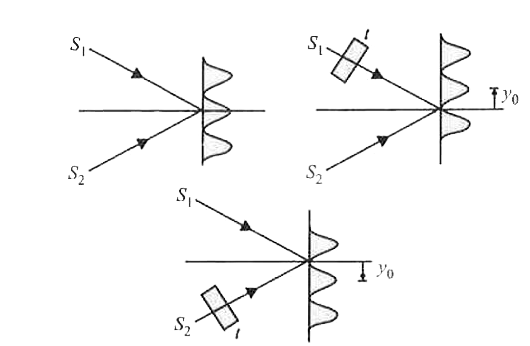Young's double slit experiment gives interference fringes of width 0.3 mm. A thin plate made of material of refractive index 1.5 is kept in the path of light from one of the sits, then the fringe width becomes
zero
0.3 mm
0.45 mm
0.15 mm
The correct Answer is:B
When a transparent sheet of thickness t and refractive index μ is introduced in one of the paths of the interfering waves then the path increases by (μ−1)t and the whole pattern shifts by
y0=Dd(μ−1)t.
Shifting is towards the side in which the plate is introduced without any change in fringe width as shownn in figure.

Therefore, when a thin glass plate of refractive index 1.5 is kept in the path of light from one of the slits, only the fringes get shifted bu the fringe width remains unchanged i.e. 0.3 mm.
Similar Questions
In young's double slit experiment the fringe width is 4mm. If the experiment is shifted to water of refractive index 4/3 the fringe width becomes (in mm)
View SolutionObtain the expression for fringe width in the case of interference of light waves.
View SolutionIn Young's double slit experiment the fringe width is 4mm .If the experiment is shifted to water of refractive index 4/3 the fringe width becomes (in mm)
View SolutionObtain the expression for fringe width in the case of interference of light waves.
View SolutionIn Young's double slit experiment, the fringe width is beta . If the entire arrangement is placed in a liquid of refractive index n, the fringe width becomes :
View SolutionYoung’s double slit experiment gives interference fringes of width 0.3 mm. A thin glass plate made of material of R.I. 1.5 is kept in the path of light from one of slits, then the fringe width become :
View SolutionDefine coherent sources of light, fringe width and interference of light. Show that the width of dark fringe is equal to the width of bright fringe in Young's double slit experiment.
View SolutionFringe width for dark fringe differs from fringe width for bright fringe, in Young's double slit experiment.
View Solution

